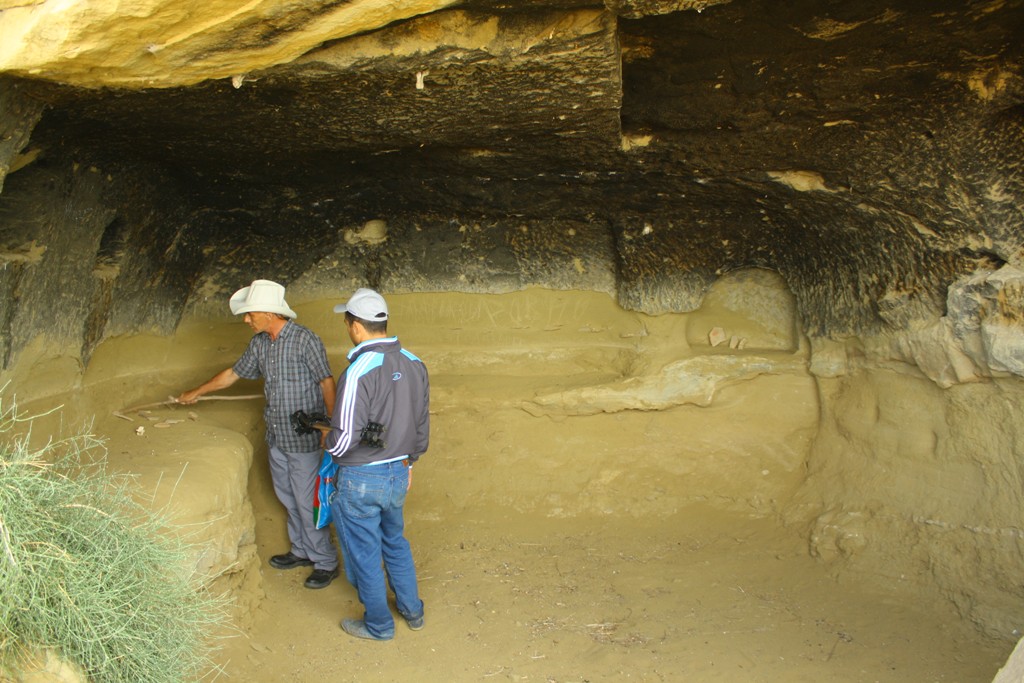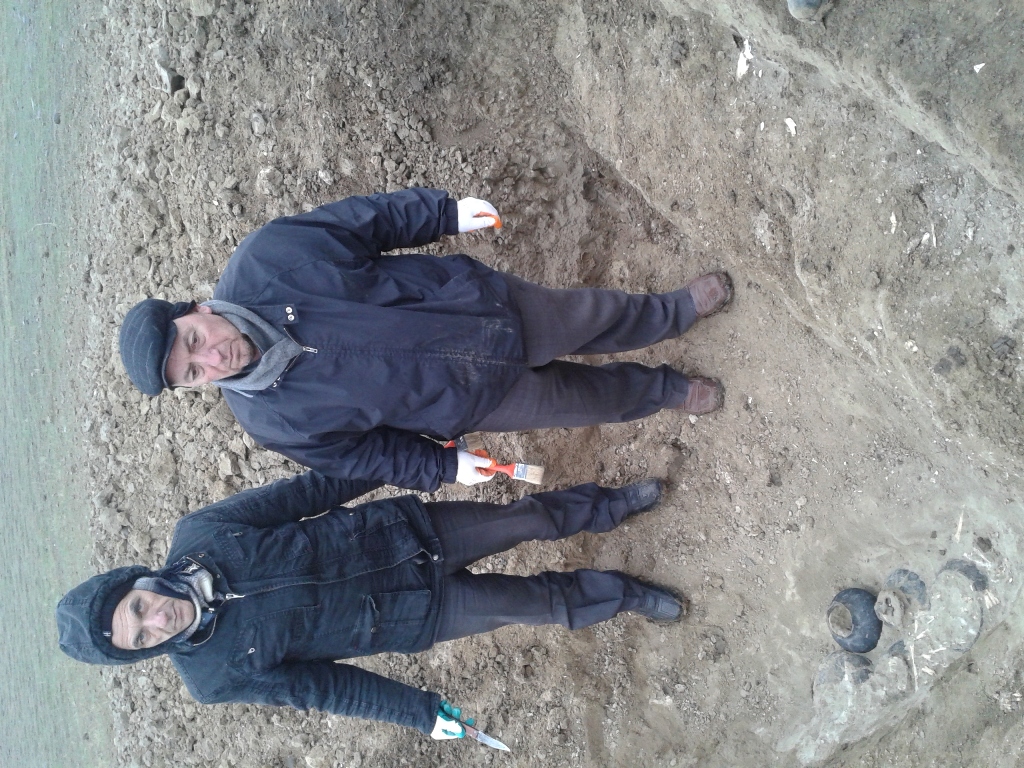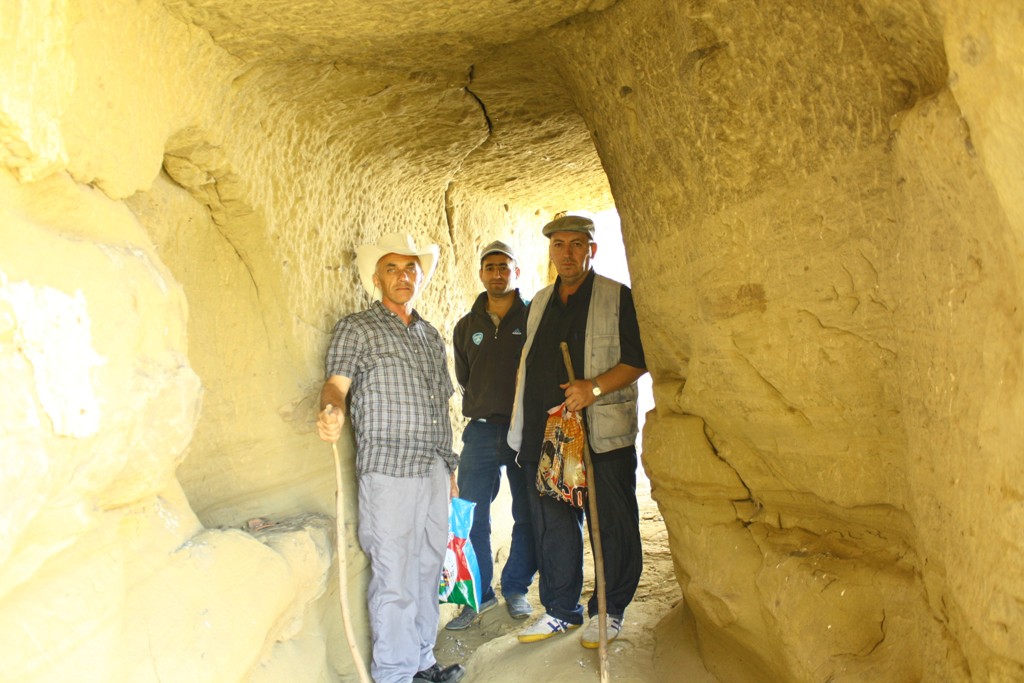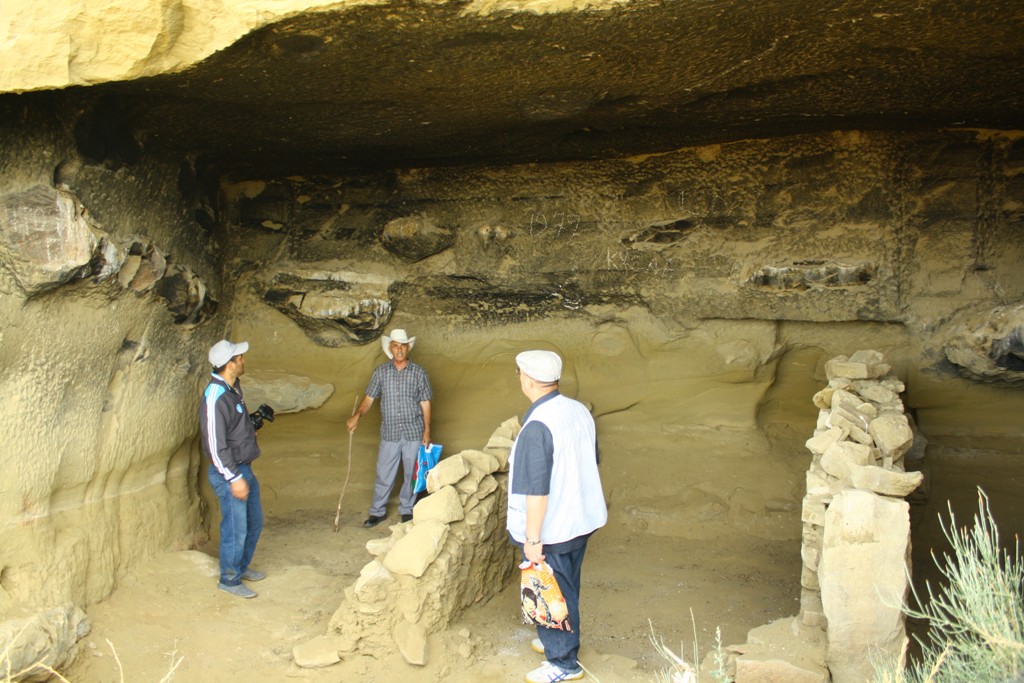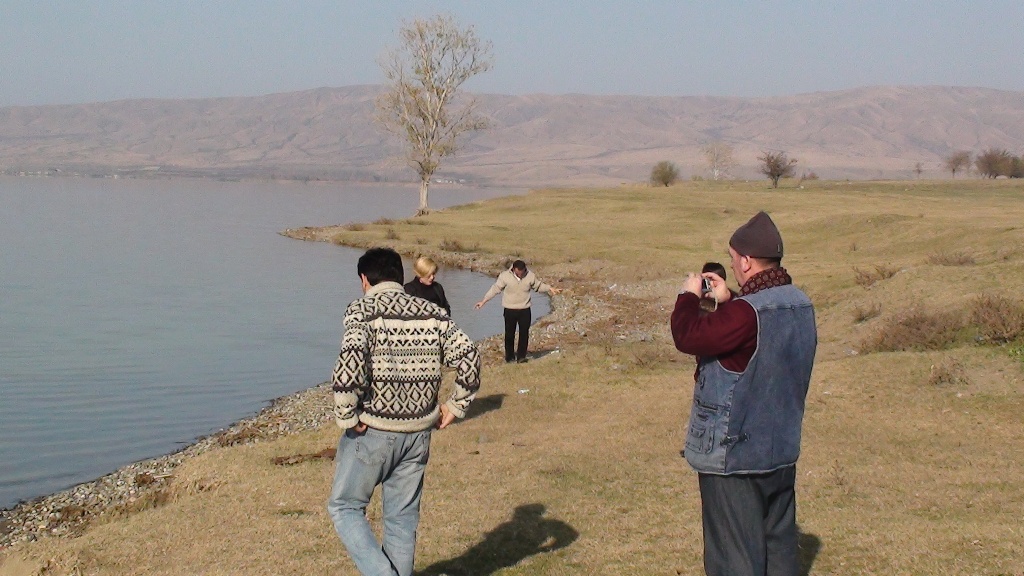Monuments’ complex of Keshikchdagh was built in the lands of Kambisene region that historically was the unit administrative territory of Caucasus Albania. In the boundaries of Modern Azerbaijan and the Republic of Georgia, the monumental complex of Keshikchidagh situates in the territories of Agstafa region and such Aveydagh, Tatli, Yukhari Askipara complexes (12.132; 4.36), Cheremi, Gurcaani (Gurcaani region), Areshi Nekreshi, Dzveli Gavaza (Kvareli region), Pokhoraulebi (Telavi region) that stayed in the territories of the Republic of Georgia and etc. (12.14) monuments are belonged to the culture of Albanian Christianity and view point of archeology and architecture most of them were investigated (3; 5; 6; 7; 15; 16; 17; 18; 19; 20; 22; 24; 25; 27; 28; 29; 30).
In 1966, Telavi group (head Ts.N.Chikoidze) of archeological expedition of Kakheti (chief K.N.Pitskhelauri) carried out excavation works in Christianity monuments of Pokhoraulebi. M. Khalilov took into account that these territories included to the borders of Albanian history and being rightly notified that the same territories belong to the culture of Albanian Christianity (12.14; 36.129; 29).
In 1975, R.M. Vahidov and N.M. Guliyev looked through the monumental complex of Christianity in Askipara village of Agstafa region (34.46).
In 1975, R.B.Goyushov and A.B.Nuriya noted the remainders of three nefliChristianity monuments in Tatli village of Agstafa region (33.43).
In 1985, the archeologists C.Rustamov and F.Muradova were in archeological exploration tour in the monumental complex of Keshikchidagh (archives of ChTSh, h-214).
In 2008 and 2009, M.Mansurov and İ.Hajiyev looked through the monuments, monasteries and temple complexes of Christianity in the left bank of Kur River, in the boundaries with Georgia, in the territories of Keshikchidagh (8.71).
Jeyranchol cave temples assume special importance among such monuments. Jeyranchol cave monasteries were built on the left bank of Kur River, in Jeyranchol in Keshikchi castle of Keshikchdagh and near the Gudrat and Saloglu springs. In the result of mince in some of layers there have created refuges with one or with many dining rooms, prayer hall, welfare and economy rooms’ settings, water reservoir and storage rocks in each three territories layer mince. In some of these caves there were corridor for comings and goings. There are two layers’ and two storied caves in Keshikchidagh too. In one of the caves was a way for going up from ground floor to the first floor is on the entrance door and distracts the attention. There are supposed that, such doors used for especial protection purposes. In another cave in two places inside of the rocks there were built the places for clearing out water. At first, by the mean of chute the running water flew into the same holes and after oozy precipitation they gathered in the well that was made for water reserve and was built on the rocksof the mountain. Taking into attention the coolness of the well on the top part there was made food storehouse placeas a refrigerator. Inside of the same cave there are some niche places for putting lights. Beside with nature caves, there are also artificial caves and it informs us about the building technics. On the walls and ceilings of some of rooms there are polychrome descriptions and writings on the lime plaster with Christianity motives. According to M.J. Khalilova’s thoughts, in the XI centuries such descriptions could be created in the result of collapse of Albanian state and after including these territories to the composition of Erathy Georgia and Georgia’s church influence (12.166).
Instead of M.J.Khalilov connected this event with including of these territories to the composition of Erathy prince provisionally and collapse of Albanian state in 1080. But from the history it is known that, in 705, there put the end to Albanian state by Arabians and created the independent feudal states and in connection with this, in Azerbaijan rebirthed the state traditions since the IX century (12.84).
In our opinion, there was impossible to increase the Georgian’s elements in these caves, because with the creation of Tiflis Muslim Emirates in the VIII centuries, there raised the influence of Islam religious and also this territory was under the influence of Seljuk in the XI centuries.
In 1121, after Didgory victory of Georgians and in 1122, after abolishment of Tiflis Muslim Emirates instead of the Georgians’ influence partially increased the influence of Islam religious was very strong from creation of Tiflis Muslim Emirates in the VIII century and till 1121. During the XI-XIII centuries, Ganja and surrounding territories were the center of Renaissance of the culture both Muslims’ and Albanian Christians. Within this period the role of Ganja was very high under the influence of literary environment of Barda in attaining of such famous envoys as Nizami Ganjavi, Abu Ula Ganjavi, Gvami Ganjavi, Mehseti Ganjavi and etc. well – known workers of culture of Albanian Christianity as David Alavik, Mkhitar Gosh, Kirokos Ganjali, Boyuk Vardan Albanski, Patmich, Smbat Sparapet, Khetun Patmich (21.707).
At the next periods of history these territories were under the influence of Muslim states as Atabegs State, HulaguState of Ghazan Khan that saw the highest ascendancy of Islam and adopted Mohammedanizm, Karaqoyunlu, Agqoyunlu, Safavids, Ganja khanate so there was not any opportunity to talk about the Georgians’ superior position in the same territories.
We can only note about the provisional superior of Georgians’ tsar in the 40th years of XVIII century that was created by Garabagh khanate against of Ganjakhanate. Thus, in the territory of Ganja khanate that was created in 1748, collecting assessments were divided between Garabagh khanate and Georgians’ tsar. It meant the enervation of Ganja khanate and in its turn, it diminished the control of Azerbaijan in the West territories.
On the base of Georgiyevsk tracts in 1783, Georgia was under the patronage of Russia and here created the new conditions for encroaching on Ganja and Erevan khanate but it was not in systematical characters.
In 1801, on the base of agreement of Georgiyevsk Georgia passed to Russians’ patronage and again when it was registered officially the historical territories Gazakh, Borchali, Shamshadil and Pambak regions of Ganja khanate with Russians’ hand joint to Georgia.
In 1804, breaking down the resistance of Ganja population and Javad khan was assassinated the territory was passed under the power of Russians.
In 1828, Tsar administrative in the way of deportation of Christian people from Turkey and Iran to Caucasia pursued the policy of ethno demographical changes of Caucasus and created the “Armenian province” in the historical territories of Azerbaijan – in the lands of Nakhchivan and Erevan khanate by placing of Armenians in Garabagh, Nakhchivan and Erevan khanate (The history of Azerbaijan, Baku, 2005, pp.600). Tsar administrative pronounced joint judgment about the Armenian Gregorian church in 1836, and included there the special article about the church of Albanian Apostolic Avtokefal and on the base of this, it deprived Albanian church from avtokefal and this church was subordinated to Echmiadzin in the position of Eparchy. When Armenian Church gained the national cultural heritage of Albania they achieved to change of completely image and this situation also expresses as physical annihilation of it (22). There begins the ethnical processes of Albania. Even M. Barkhudaryants noted that since 1836, Albanian monasteries have not any archives or libraries, everything was disappearenced, was stolen large sum of valuable manuscripts. In the monasteries were not carried out pilgrimages for months. Because there were not any educated men, schools, monks and librarians (Makhar Barkhudaryants, Arsakh, I.35). In accordance to the thoughts of investigators, one part of Albanians adopted Islamic religious, one part becomes Gregorian’s – Armenians, one part becomes Georgians by adopting Orthodox religious. The synod documents show that the Albanians could save their religious for a long time (21.710).
In our opinion, if we pay attention that the Azerbaijan population is the historical inheritance of Albanians so, there is impossible to talk about becoming of Albanians into Armenians or Georgians. Thus, with the abolishment of Albanian Catholicizes in 1836, Christian Albanian monuments in Azerbaijan stayed without attention and in the same monuments began to create Armenian and Georgian elements. According to the decision of Petersburg’s Synod in 1836, the activities of Albanians monumentsstopped with purposely and officially, then there created the Armenianelements in Albanian temples in Garabagh, the Georgian elements in the monuments of the West region. Their purpose was to put forward the claims on our historical lands by Armeniation and Georgianization. Because since the XIX centuries,Azerbaijan was joint to Russian Empire and instead of this situation the Islamic religious were strongly supported and widely surrounded in the territory so that the Christianity monuments of Albania was remained out of attention and they wanted to use from this situation. Thus, in Albanian cave monuments in the territory of Agstafa region on Keshikchidagh could be create the Georgians’ elements only in the first half or in the middle of the XIX centuries.
In June, 2012, the results of carrying out archeological excavation and exploration works on Keshikchidagh also gave us the basis for affirmation of these thoughts. The archeological excavation works gave us to substantiate that the first dwelling houses created at the end of II thousands years – at the early of I thousands years of B.C. And this gave us the opportunity to base the creation of fenced dwelling houses were in the connection with the iron discovery in these territories. The natural fences on the top of the mountains created the real conditions for these. At the bottom of Keshikchidagh, the graves in the form of kurgans affirmed our opinion again that are in Jeyranchol – and belongs to the end of II thousands years – at the early of I thousands years of B.C. One of these kurgans investigated by the archeologist N.Museyibli in 2009, and two of them investigated by archeologists I.Hajiyev and A.M.Mammadov in June, 2012. In one of investigated kurgans by I.Hajiyev and A.M.Mammadov the stone – box grave determined that was cenotaph (empty). On the base of straggling position of upper covers of graves we can say that most of them were plundered by nomadic cattle-breeders. Suddenly opened the third grave the skeleton was placed in bitumen, so that it kept as it was.
From another two graves have gotten many numbers of material and cultural survivals belonging to the Last – the First Iron Age.
During the archeological exploration works discovered material and cultural survivals especially, glazed earthenware from the cultural sectionof different periods gave us an opportunity to determine that in Ancient, in the Early Middle Ages, in the developed Middle Age and in the Last Middle Age were successively living on the territories of Keshikchidagh. All of these created conditions to follow the identities, successions, inheritances in material culture of our population.
During the archeological exploration works has determined that, there are completely 72 caves in the territories of Keshikchidagh. Instead of some caves are natural but most of caves werecreated artificially (2.20, 19.36, 27).
Term of cave monument first of all used by R.B.Goyushov, R.M.Vahidov, N.M.Quliyev and others. But anothers expressed this term as “church of rocks” (35.5).
In the XIII centuries, Kirakos Gandzaket an author of Albania when talked about oppression of Albanian Catholics during the XII-XIII centuries he noted that they were led to Albanian churches from the cave on the mountain near Ganja territories (The Kirakos Gandzaket’s history, VI chapter). If we consider that the biggest cave temples are near Ganja in the territory of Agstafa region it is probably, the leaders were placed in Keshikchidagh. Paying attention that for the first time the center of Albanian monuments were in Chola, then in Barda and then in Berdakur not far from these territories and Ganjasar it could be supposed that since the XIII centuries, the leadership to church was places in Mahrasa (Moon temple) temple, in the territory of Gadabay region, at the left bank of Shamkirchay, near the territories that known as Giz Qalasi, Gizil Gaya, Namard Gala among the population.
Keshikchidagh cave temples situate on 25-30 cm higher from the floors of sanctuary hall in the built churches. In this case the priest point of view of physically is near to the prayers. It also appropriates the faith of Jesus (Christ) was a man. Such architectural technique corresponds with the building peculiarities of the Early Middle Age (7;28;35). The same position was observed in the monuments of Meshali (Kharkaput), Shaki, Kish, Gakh, Lakit, Yelisey, Ganjasar, Chaykend, Garabulagh, Gum, Khudavang, Gadabay, Mahrasa and Mingechaur in the territory of Goranboy (5.156;7.31;19.174;26.30;27.40).
In some of monuments determined one or two graves. The investigations showed that, these temples existed till the excavation of the graves.
So that one part of the grave is on the foundation of temple. Here also were made a little niche for completely placing of dead body in the grave’s camera.
The observations show that, when Georgians carried out reconstruction works they acted carelessness and the skeleton smashed to pieces during the excavation works in the XIX centuries. Thus, it assumed as sacred man and there were engraved particularly grave, the cranial and fixed bones were burial there.
Although, the cave temples created in the Early Ages of B.C. of course they were widely used during the forced praying period of Christianity. From the historical events it is known that oppressing processes of Christianity began by Sassanid Empire and straightened during the period of the II Yazdegerd. During the VII – IX centuries, the military operations of Arabians in the territory of Albania, during the period of Ioannes Catholicos (in 797-822) the movement of central headquarter of Albanian Church from Barda city’s plain to Berdakura the mountainously areas of Garabagh would be lead to increase the living in cave temples. Also the investigator R.B. Goyushov notified that with the joining of Albania to the composition of Caliphate the number of cave temples increased.
The investigations show that, even at the beginning of B.C. the Keshikchidagh caves were the praying places of idolatrous. After religious changes Keshikchidagh cave could save its holiness as other altars, in the V centuries reconstructed in the period of Vache II, and the number of rooms were growth. In the places of monuments there took attention of not difficult sharing of caves and during the VII – VIII centuries, in the period of Arabian occupations the Christianity Albanians made here additional refugees too. In the cave and monuments were carried out the following reconstruction works in the XIX centuries, and it fulfilled the role of both praying house and the den of robbers.
Building Keshikchi tower in the same territories were built on the rock and its height reaches to 11 m and consist of three floors. In some parts of the cave there were built strongholds inappendix form for increasing the strengthening. The width of the cave is 5 meters, measures of appendixes are 1.30 x 50 cm.
There is a small yard near the cave, for ascending to the yard and there are stairs to the cave, the guard places, in the part toward the cave there was a well in the form of oven and with the burn’s trucks. There is not any information about what they were used for. Might be there was gathered water and followed into bottom reservoir. In the building of the tower there were used from the rock stones, but for completing the intervals among the floors there were used from the bricks with the size of 25x20x4 cm, 25x18x4 cm.
If we pay attention that the production of burnt bricks began since the VIII-IX centuries, then we can say that Shaddad was one of the building for protection systems of transmission and surveillance that created in the X century and the center was Ganja city. The same castle was served to controlling of trade caravan route in Agstafa – Poylu –Kasaman – Saloglu – Muganli villages, to Karvan valley – Saggizli valley and passing Qara plain toward the West that were used all the centuries long. In the side of the roads the direction informed signs being known as “Galin Qaya”, “Choban Dash” substantiates our opinions.
When we talk about the caves that are on Keshikchidagh we know that these territories were Albanian monument and built on the rocks during the V-VII centuries and but in 50-60th years of the XX centuries during reconstruction works there were added Georgian elements.
These thoughts proved by the photo that was taken in theyear of 1948 and reflected in the scientific article of Q.N. Chubanashvili that published in Tiflis.
The monuments on the mountain are in accordance with the same periods of creation of Khunan and Khalkhal cities that were superior in position in Gazakh – Agstafaterritoriesin the Early Middle Ages (37).
In spite of cave monuments, Keshikchi castle and churches on the mountains including to Keshikchidagh monumental complex were built in the different periods we can never deny that in generally they are material resources of our people.
R E F E R E N C E S
- Vahidov R.M. Mingechaur III – VIII centuries (on the base of archeological excavation materials), Baku, 1961
- Vahidov R.M., Guliyev N.M. Archeological excavations on Kilsa (Church) mountain / in 1971, carrying out archeological and ethnographical investigations in Azerbaijan,Baku, 1972, p. 19-21
- Narimanov İ.H.The grave of Javanshir the lord of Albania. / Ethno and cultural heritage of Caucasian Albania, the international scientific conference, Baku, 2001, p. 42–43.
- Mammadov A.M. The monuments of Christianity of Ganjabasar of Albanian period, Baku, 2000, p.55.
- Mammadov A.M. The monuments of Albania in Kharkhaput (Meshali) village // The history and its problems, № 3, p. 157-159
- Mammadov T.M.Caucasian Albania in the Early Middle Age, Baku, 2006, p. 399.
- Mammadzadeh K.M.Architectural observations in Yelisey monumental complex / In 1971, carrying out archeological and ethnographical investigations in Azerbaijan,Baku, 1972, p. 30-31
- Mansurov M.M.About the cave monasteries of Jeyranchol / the materials of scientific session that dedicated to the results of archeological and ethnographical investigations that were carried out in 2003-2004 years, Baku, 2005, p. 71-72
- Muradova F.M. The monuments of Albania in Gazakh (archeological and ethnographical investigations in Gazakh region (collection)) // Editors: A.Mammadov, E.Abbasova, Ganja, 2008, p. 174-178
- Muradova F.M., Rustamov C.N.The monuments on Avey mountain of the period of Albania. / The materials of scientific conference that dedicated to the last results of architectural and ethnographical sciences in Azerbaijan. Baku, 1992, p. 54-56
- Moisey KalankatukluThe history of Albania, Baku, 1993, pp. 235.
- Khalilov M.J.The Christian monuments of Albania. (theIV – X centuries), Baku, 2011, pp. 341.
- Khalilov M.J.Grave monuments of Albania (the IV – X centuries), Baku, Nafta-Press, pp.180.
- Khalilov M.J.Dwelling houses of Albania (the IV – X centuries), Baku, the publication house of Khazar University, Baku, 2010, pp. 284.
- Goyushov R.B. Amaras – Aghoghlan, Baku, Elm, 1975
- АslanovК.М.Izistoriimaterial’noykul’turi Kavkaziskoy Albanii I – IV vv. Sb., “Voprosi istorii Kavkaziskoy Albanii” Baku, 1961, 125-130
- Babayev I.A. Qoroda Kavkaziskoy Albanii v IV v. do n.e. – III v.n.e. Baku, 1990, 234s.
- Baranovskiy P.D. Pamyatniki v selenyax Kum i Lekit / Arkhtectura Azerbaydjana epokhi Nizami, Moskva – Baku, 1947, s. 29-33
- B.Khristianstvov Kavkaziskoy Albanii (po dannim arkheoloqii I pismennikh istochnikov), Baku, 1984. 192 s.
- Nuriyev A.B. Remeslo Ремесло Kavkaziskoy Albanii, Baku, 200-, 433 s.
- Dj. Kavkaziskaya Albaniya I albani, Baku, 2005, 798s.
- МаDj. Politicheskaya istoriyaI istoricheskaya geografiya Kavkaziskoy Albanii, Baku, “Elm”, 1986, 284 s.
- Мkhitar Qosh Albanskaya khronuka, Baku, 1960
- Trever K.V.Ocherki po istorii kulturi Kavkaziskoy Albanii (IV v. do n.e. – VII v. n.e.) M-, AN SSSR, 1959, 389 str.
- Оsmanov F.L. Istoriya i kultura Kavkaziskoy Albanii, Baku, 2006, 285 s.
- Кеrimov V. Khram Zeyzit Kavkaziskoy Albani / Istoriya, architectura, arkheoloqiya, Baku, 2008
- КаrakhmedovaА.А.Khristianskie pomyatniki Kavkaziskoy Albanii (Alazanskaya dolina), Baku, 1986
- Useynov M.A., Bratenichkiy L.S., Salamzadeh A.V. Istoriya arkhtecturi Azerbaydjana, t. 1, Bакu – Моskva, 1963, 393 s.
- Q. VoprosiistoriiEreti (Ocherchisochial’no – ekonomicheskoy istorii), Izd-vo Mechniereba, Tbilisi, 1970, 371 s.
- Yampol’skiy Z.N. Drevnyya Albaniya v III-I vv. do n.e. Baku AN Az.SSR, 1962, 381 s.
- Еsan Khasan DjalalКratkaya istoriya strana Albanskoy (1702 – 1722 qq.), Baku, 1989, 45 s.
- Chubinashvili Q.N. Pshernie monastiri David – Qeredji (ocherk po istorii iskustva Qruzii), Tbilisi, 1948, 117 s.
- Qeyushev R.B. Poselenie Tatli / AEIA (1975 q.) Baku 1978, str. 42-44. Niriyev A.B
- M., QulievN.M., Qasimov E.A. Arkheoloqicheskie raboti Tauzskoqo otryada v 1975 qodu AEIA (1975 q.), Baku 1978, str. 44-46
- МаQ. ZodchestvaKavkaziskoyAlbanii. Baku 2004. (224 str.)
- N.Pomyatnikranneqosrednikov’yabliz.q.Telavi, TKAE (1965-1966 qq), 1, Тbilisi, 1969,Меchniereba,s. 128-136
- M.New glaze to the history of Khunancity in Gazakh region.
- Abbasova E.J. Archelogical and ethnographical investigations (Collection) / Editors: Allahverdiyeva S.K Mammadov, E.Abbasova. Ganja 2008, pp.178


